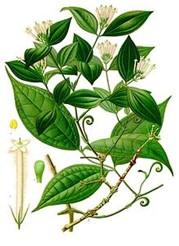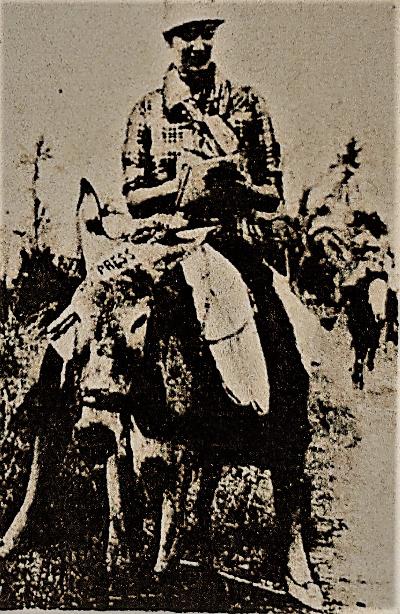 Strychnos, species
Strychnos, species
My Aunt Evelyn’s Trip to Haiti ini1959
Ed Johnston, September 2020
…if a memory is great enough, other memories will cluster about it, and those in turn will bring their suites of memories to gather about this focal point, because perhaps, they are all scattered parts of the one thing… Zora Neal Hurston
Staff Reporter Evelyn DeTardo was twenty-three when the The Miami Herald sent her on an extended trip to Haiti to investigate reports that a witch doctor (“bocor”) was making zombies to labor on his tobacco farm. She hitched a ride on a friend’s sailboat and headed southeast to Port-au-Prince (in creole “Pόtoprens”) where she was met by Bernard Diederich, editor of the The Haiti Sun newspaper, and pastor Wallace Trunbull. Together they made the two-day journey north in jeeps and over donkey trails, to Bombardopolis in the hilly country of the Mole-Saint Nicolas arrondissement where they found Father Laroche, curé of the Catholic mission there since 1948.
Father Laroche’s story
Father Laroche had been summoned to the police station to speak with the alleged zombie who’d been apprehended near the local cemetery. He claimed he’d been ordered to dig up recently buried Joseph Portalis, who had been under the care of a leaf doctor named Enacier. (This was long before Leaf Doctor was a free iPhone app for assessing plant diseases.) Leaf doctors then treated patients withrherbs. herbs.
Father Laroche recognized the alleged zombie as Elius from the nearby town of Jean Rabel, and indeed Elius recognized Laroche saying “I remember you from three years ago, the day I was buried.” This got Laroche’s attention. He continued to question Elius, who paced the room “as if floating,” and never sat down but perched on a bench like a bird. Elius was emaciated with halting speech. His story was that Enacier kept five other zombies, two being women, to labor at night on his 20-acre farm. In the day they were kept in a series of caverns and fed mostly with sourioranges.

Haiti Map with line showing journey they took
Laroche clearly believed zombies were real. The basis he explained is a curare of the genus Strychnos, species used by some indigenous tribes in South America and Africa. “The results of taking this drug is (sic) as close as man has ever come to the living dead…it destroys the brain tissue to such an extent …the victim is incapable of returning to a normal life.” The fact that young Joseph Portalis was under the care of Enacier is suspect.
Laroche explained the process is twofold. A mix of herbs and other psychoactive substances from puffer fish, sometimes cane toads is given to the victim. This “puts them in coma so deep that heartbeat, pulse and breathing are imperceptible.” The victims, believed dead by family, are buried only to be dug up and “resurrected” with a second concoction and enslaved.
The day of the interview, Enacier’s son was seen near the grave of Joseph Portalis. That same day, Postalis’ widow died suddenly.
Shortly after the mysterious death of Joseph Portalis’s wife, Enacier himself showed up at the Bombardolpolis police station, allegedly bribed a corporal with 400 gourdes (Haitian dollars), and had Elius escorted to his hometown of Jean Rabel. Two days later, he was found truly dead on a nearby trail. That corporal was reassigned elsewhere.
Travel to a Bocor’s Farm
DeTardo, Diederich and Trunball decided to travel into the rural outskirts of Bombardolpolis to find Enacier. It was a three-hour ride by donkey. His farm was in a jungle valley bordered by high cliffs. My aunt would write, “We decided that looking for a zombie here would be like trying to find a needle in aihaystack.”
Enacier’siStory
The visitors found Enacier in his garden by the river Henne that flows through his farm. Diederich would later write, “Pleading his case with senatorial repertory and demonstrative hands,” Enacier with “blazing hypnotic eyes” made a “Mark Anthony appeal to his visitors.” He claimed he was a prisoner on his own farm, and the so-called zombie was a crazy nephew. He called the towns people of Bombardopolis “witless” and claimed he was the victim of their “witch hunt.” His denial of being a bocor was maybe protesting too much. The story my aunt wrote and the story Mr. Diederich wrote left readers to ponder. Enacier did, however, grow lots of sour orange.

Evelyn DeTardo on the three-hour donkey ride to interview Enacier.
A LittleiHistory
In 1985 Harvard educated Anthropologist Wade Davis (now Explorer in Residence at the National Geographic Society) wrote The Serpent and the Rainbow to reviews like, “Exotic and far-reaching. . . a corker of a read, just the way Indiana Jones would tell it.” (The Wall Street Journal ) and “Zombies do come back from the dead, and Wade Davis knows how.” (Washington Post Book World). In far more scientific words, detailed research and experience, he had written what Father Laroche had told my aunt some twenty-six years prior regarding how a zombie comes to be. When Dr. Davis’ work was questioned by other scientists, he did more extensive work demonstrating, again, that zombies are real, albeitirare.

Bernard Diederich
Just over twenty-two years prior to my aunt Evelyn’s Haiti trip, celebrated author Zora Neale Hurston was there to write about voodoo and zombies. Her experiences, adventures and stories are all contained in Tell My Horse [1]. Huston not only wrote that zombies are real, she detailed meeting a few and photographed them. There are not, she wrote, legions of zombies working as slaves but bocors will make zombies for labor, profit and sometimes revenge. There are children made into zombies to work as thieves for the bocor. When explaining what drug mixture can make and maintain the “life” of a zombie, Huston wrote something similar to what Laroche had said but added “some secret probably brought from Africa and handed down from generation to generation. These secret societies are secret. They will die before they tell.” She felt that western science would never fully understand.
My aunt would later work for Time magazine and continue her trips to Haiti, writing about the “Voodoo Dictator” Papa Doc Duvalier. Bernard Diederich would continue at The Haiti Sun until being expelled from Haiti in 1963 after angering Papa Doc. Diederich and my aunt made at least one other expedition together to interview the voodoo houngan (male priest) of Archaie, Haiti.
[1] “Tell my horse” refers to a purely Haitian god of the common people named Guedé (geeday), an irreverent and sarcastic god who insults the upper classes, politicians and the arrogant.

Enacier and Laroche- Above is an excerpt of The Haiti Sun story on March 15, 1959, by Bernard Diederich. My aunt’s story ran a full page in The Miami Herald on April 12, 1959.

This is an interesting glimpse into a debate about whether zombies are real, which dates to at least the 1880s, and it’s fascinating to read the background and personal history of Evelyn’s trip in that context. Laroche’s description of the process is especially prescient, as the mention of puffer fish and sometimes cane toads being included in the poison would later be well documented by Davis. For a more scholarly version of Davis’ work, I recommend Passage of Darkness: The Ethnobiology of the Haitian Zombie, published in 1988. While Davis does not cite this specific account, he was very likely familiar with it, since he included a sampling of similar representative cases, and cites Diederich. Stories like this helped document Haitian folklore, and continued to spur interest in answering questions about this practice.
Comment by JD Baker on 11 October, 2020 at 12:51 amThanks for the informative comment JD Baker! Worth more research.
Comment by Edward P Johnston on 11 October, 2020 at 5:08 pmOn a different level, I was very much alive in 1959 and admit that at that
time, for a young woman like my aunt to travel mostly alone to go on such
an expedition was out of the ordinary.
This part of her life was lost until I came across Claire Palmer’s –
“Papa Doc Blood” which is the inspiration it took for me to start
the research which lead to finding the information on my aunts
trips to Haiti and writing about it.
Thank you for the remarkable story, very interesting. There is so much we do not know about medicinal plants and how they are and were used for good and evil! It made me want to read more!
Comment by Elaine Edington on 14 October, 2020 at 2:21 amI am ultimately impressed by Evelyn DeTardo; what an intrepid young woman of that era and travel alone on such an adventure! This is a fascinating story all around and would make an excellent screenplay!
Comment by Sunita Przewlocki on 3 November, 2020 at 5:06 am